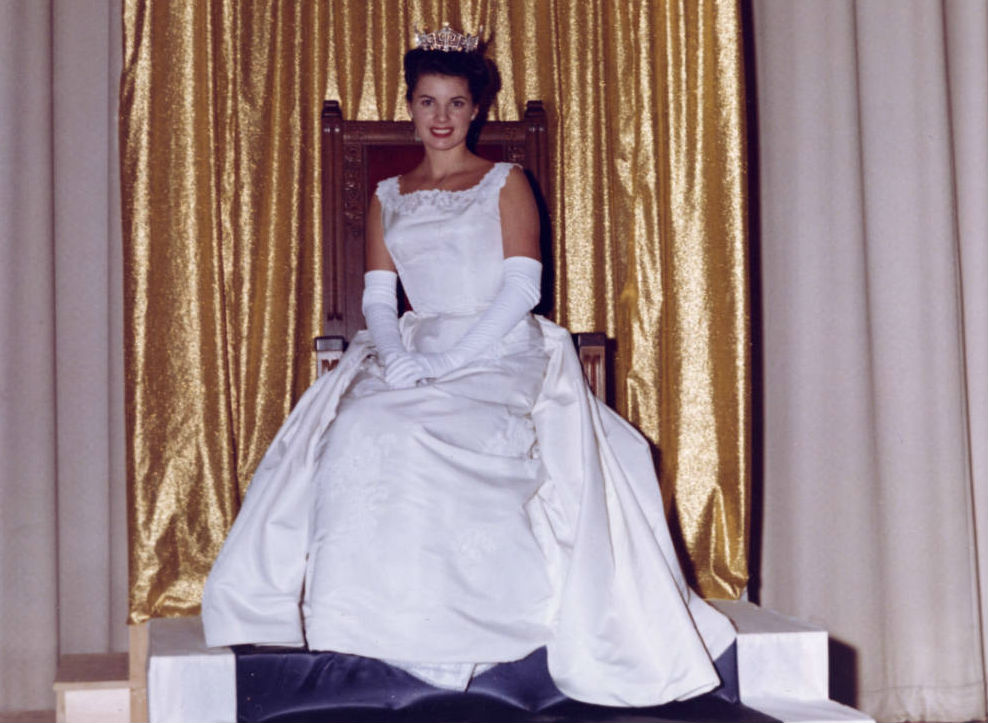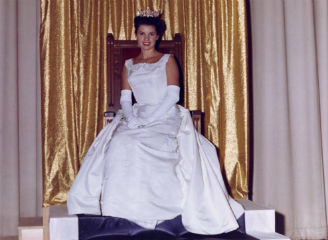
COLUMBUS, Ohio (AP) – A tiara on her head and a rose in her lap, the smiling young woman practically radiates from the oil painting.
Jackie Mayer of Sandusky, Ohio, had just been crowned Miss America when she sat for the portrait in the fall of 1962.
Forty years later, Mayer donated the painting to the Ohio History Connection (formerly the Ohio Historical Society).
The painting might not be Mona Lisa, but History Connection officials nonetheless view it as a prized possession.
“We’re not going after Monets and Picassos that don’t fit our mission, which is to tell stories about Ohio,” said Becky Odom, a history curator for the group.
The portrait is among almost 2 million items that nearly fill the six North Side warehouses used for storage by the History Connection.
More than 99 percent of the items were donated. And each one, as Odom said, tells a story.
A recent tour of the warehouses revealed some notable examples:
When Jackie Mayer-Townsend, now 73, started contemplating the future of her gowns and other memorabilia, she ruled out passing them to her two children (son Bill and daughter Kelly).
“It’s mine,” she said of the collection. “I have given them a scrapbook and a couple other things I had.”
She chose instead to donate them to the Ohio History Connection, she said, because she knew they’d be well maintained.
“I wanted to have all that memorabilia kept in one place, and I wanted everything to be pristine.”
Nowadays, about 20 gowns Mayer wore throughout her pageant career remain together in a metal storage locker. (All of the warehouses are climate-controlled.)
Odom said she would love to have Mayer’s tiara, too, but the beauty queen has yet to determine its future.
The simple jean jacket is well worn, with a Cleveland Indians patch on the left arm and a Sergeant Pepper’s Lonely Hearts Club Band patch on the right shoulder.
Only when Odom points out a small hole in the right wrist does the jacket become meaningful: It was worn by Kent State University student Alan Canfora on May 4, 1970, the day that four people were killed and nine (including Canfora) were wounded when National Guard troops opened fire on Vietnam War protesters at Kent State Univeristy.
“So many pieces we have in our collection have witnessed history,” Odom said. “Who thinks about what they’re putting on in the morning to go to work or go to school, and then it’s something that witnesses an event that is in the history books forever?”
The warehouses also house the group’s extensive natural-history collection, with drawers holding specimens of birds and insects.
Among the more unusual items are bones and teeth from mammoths and mastodons unearthed in Ohio, as well as a giraffe skull found on the banks of Blacklick Creek near New Albany.
No, giraffes have never lived in Ohio.
“We think it must have been a circus escapee,” said Erin Cashion, a natural-history curator.
Nearby, yet another warehouse contains the state archaeology archives, including 13,000-year-old Clovis spear points and arrowheads as well as a treasure trove of items from the Hopewell people, who inhabited Ohio about 2,000 years ago.
In the upper floors of the Ohio History Center museum are the state’s archives – or, at least, as many of the documents and papers that can fit there.
While the warehouses are at about 97 percent capacity, officials say, the archives are completely full.
Burt Logan, executive director of the Ohio History Connection, said the group hopes to relieve the pressure by expanding the center and by identifying and acquiring property for a new facility Downtown (a process that is in the early stages).
For now, though, the stacks hold box upon box of papers, ranging from the dry (minutes from the General Assembly) to the colorful (such as an ice-cream carton once dropped on Cleveland from a B-17 bomber).
The latter item was donated by Shaker Heights resident Dick Parke, whose father, C.W. Parke, was a B-17 navigator during World War II.
In 1944, as his unit prepared to fly to Europe, the elder Parke wrote a letter to his parents, put it in an empty ice-cream carton and taped a note to the outside, asking whoever found it to deliver it.
Parke then tossed it out the bomber’s window over Cleveland. A few days later, an article and photo in the Cleveland Press detailed how a young boy found the carton on his way home from school.
Dick Parke said donating his father’s war memorabilia to the Ohio History Connection made sense. He and his wife, Jude, have no kids.
“I didn’t have anybody to pass it to,” Parke said. “And I love the fact that the (Ohio History Connection) does a good job of getting objects out there for people to see.
“Of course, everybody is biased toward their own stuff, but I think there’s some cool stories in the stuff I donated.”
___
KEN GORDON, The Columbus Dispatch
Information from: The Columbus Dispatch, http://www.dispatch.com
Copyright 2016 Associated Press. All rights reserved. This material may not be published, broadcast, rewritten, or redistributed.
AP-WF-02-21-16 1500GMT



